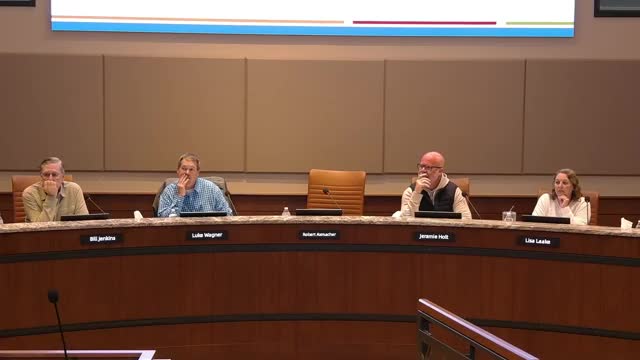Timnath presents tight 2026 budget; staff flags likely $14 million borrowing in 2027
October 08, 2025 | Timnath, Larimer County, Colorado
This article was created by AI summarizing key points discussed. AI makes mistakes, so for full details and context, please refer to the video of the full meeting. Please report any errors so we can fix them. Report an error »

Town staff presented a draft 2026 budget that projects a structurally balanced five‑year outlook but warns the plan will be tighter than recent years and likely require debt issuance in 2027.
At a work session, staff said recurring revenues are expected to exceed recurring expenditures through 2030 and the town will meet its policy minimum working‑capital reserve of 25%. The presentation noted a projected 20% reduction in building‑related revenue and permit fees for 2026 and a forecast assumption that could require about $14,000,000 in debt issuance in 2027 to pay for planned infrastructure projects.
The council heard staff’s revenue assumptions and program priorities at the Oct. work session. Finance staff summarized the forecast and said it includes shifting some sales‑tax transfers when a local TIF/TDA expires in 2029 and a General Improvement District (GID) mill levy expected to be issued for the first time in 2026 to pay developer‑related debt. Staff said those changes are reflected in the five‑year cash‑flow plan.
Why it matters: the town will likely need to balance preserving reserves and completing prioritized capital projects. Staff told the council the draft avoids “draconian cuts” but that constrained revenues — especially on development and building permits — limit flexibility.
Key details:
- Staff presented a revenue sensitivity that assumes 3% sales tax growth but does not recognize speculative large retail until projects are confirmed. Building‑related revenue and permit fees were shown dropping about 20% for 2026.
- The draft assumes a possible $14 million debt issuance in 2027 to fund infrastructure projects, a figure staff described as a planning maximum subject to change if revenues or timing improve.
- Staff said the GID will issue a mill levy in 2026 for debt service tied to developer repayment, and the TDA expires in 2029, shifting some transfers back to the town.
Council feedback and next steps: Council members asked for additional detail in the capital improvement program and for clearer timing on potential debt; staff said they will refine numbers and present the formal budget readings in November (first reading) and December (final adoption). Staff also noted line‑item request adjustments will be shared publicly for comment before the November meeting.
What staff will do next: incorporate council feedback, publish the draft for public comment, and bring a first reading in November and final adoption in December. The debt estimate is a planning figure; staff said it could shrink if revenues or reimbursable developer contributions materialize earlier than projected.
At a work session, staff said recurring revenues are expected to exceed recurring expenditures through 2030 and the town will meet its policy minimum working‑capital reserve of 25%. The presentation noted a projected 20% reduction in building‑related revenue and permit fees for 2026 and a forecast assumption that could require about $14,000,000 in debt issuance in 2027 to pay for planned infrastructure projects.
The council heard staff’s revenue assumptions and program priorities at the Oct. work session. Finance staff summarized the forecast and said it includes shifting some sales‑tax transfers when a local TIF/TDA expires in 2029 and a General Improvement District (GID) mill levy expected to be issued for the first time in 2026 to pay developer‑related debt. Staff said those changes are reflected in the five‑year cash‑flow plan.
Why it matters: the town will likely need to balance preserving reserves and completing prioritized capital projects. Staff told the council the draft avoids “draconian cuts” but that constrained revenues — especially on development and building permits — limit flexibility.
Key details:
- Staff presented a revenue sensitivity that assumes 3% sales tax growth but does not recognize speculative large retail until projects are confirmed. Building‑related revenue and permit fees were shown dropping about 20% for 2026.
- The draft assumes a possible $14 million debt issuance in 2027 to fund infrastructure projects, a figure staff described as a planning maximum subject to change if revenues or timing improve.
- Staff said the GID will issue a mill levy in 2026 for debt service tied to developer repayment, and the TDA expires in 2029, shifting some transfers back to the town.
Council feedback and next steps: Council members asked for additional detail in the capital improvement program and for clearer timing on potential debt; staff said they will refine numbers and present the formal budget readings in November (first reading) and December (final adoption). Staff also noted line‑item request adjustments will be shared publicly for comment before the November meeting.
What staff will do next: incorporate council feedback, publish the draft for public comment, and bring a first reading in November and final adoption in December. The debt estimate is a planning figure; staff said it could shrink if revenues or reimbursable developer contributions materialize earlier than projected.
View full meeting
This article is based on a recent meeting—watch the full video and explore the complete transcript for deeper insights into the discussion.
View full meeting
